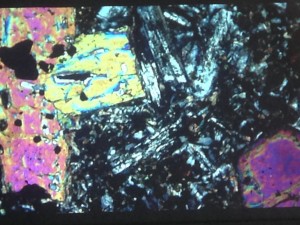Hi! My name is Grace, and I’m a senior geology major here at CC. This block I’ll be sharing my experience in Igneous Petrology. I fell in love with geology because of how differently it makes me see the world. One of my favourite authors, John McPhee, says it well “A million years is a short time – the shortest worth messing with for most problems. You begin tuning your mind to a time scale that is the planet’s time scale. For me, it is almost unconscious now and is a kind of companionship with the earth.” Like every geology class I’ve taken, I know that studying igneous petrology will further shift my perspective of our planet.
Igneous petrology is the study of the origin, composition, and chemical structure of igneous rocks. Igneous rocks are rocks that are formed by cooling magma. Rocks like granite form when magma cools below the surface, and volcanic rocks like basalt cool at the surface during volcanic eruptions. We spent our first day of class discussing how and where magma bodies are formed, and how they reach the surface to cool and form rocks. Magma can be generated in both the mantle in the crust. The specifics of these processes can be complex, but there are essentially only three ways to melt a rock and create magma: you can raise the temperature, lower the pressure, or change the rock’s melting temperature by adding volatiles such as water. It’s fascinating to think about the fact that every igneous rock started out this way, hundred to thousands of kilometers below our feet. The mighty Pikes Peak that towers over our campus today was once a liquid that slowly cooled and crystallized, then got uplifted to the surface, to become the iconic granite mountain that it is today.
On our second day of class we went from talking about massive bodies of magma to the microscopic properties of igneous rocks. One of the things I have always enjoyed about geology is the wide range of spatial and temporal scales that it covers, and this class is certainly no exception. We started the day with a lecture on optics and discussed what some common minerals look like under the microscope, then jumped into looking at thin sections for our lab. A thin section is an ultra thin (usually 30 microns) slice of rock that has been cut with a diamond saw and then sanded down until it is perfectly flat. The rock slice is then mounted onto a clear glass slide that can be studied under a petrographic microscope. Here is a photo of what one of our thin sections looks like under the microscope:

The bright colors you see here aren’t the true colors of the minerals in this rock. Instead, they’re interference colors that are caused by the light from the microscope breaking up as it passes through the crystals in the thin section. If you’ve ever shined a light through a prism and created a rainbow, you’ve seen interference colors! The interference colors that we see in thin sections can help us identify what minerals we’re looking at, since the physical properties of different minerals cause them to produce different colors. The first time I ever looked at a thin section, I was blown away by how much detail a thin section can reveal about the history of the rock. The proportions of different minerals, the shapes of their crystals, and the boundaries between crystals can all provide valuable clues about the rock’s crystallization history.